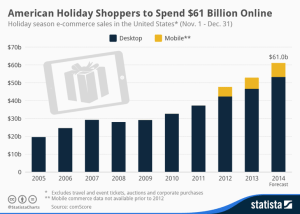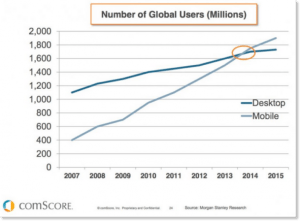The year is quickly coming to a close.
This is undoubtedly the most important time of year for one reason: Shopping. The holidays bring out hordes of shoppers jumping on the latest deals from retailers clearing out inventory. But just how much do consumers spend during the holidays? The graph below looks at holiday spending online for the previous years:
The National Retail Federation (NRF) anticipates online sales to reach an astounding $105 billion in 2015. Major retailers are naturally pushing hard to attract the huge influx of holiday shoppers. But as a small business owner, how can you drive more sales this holiday season?
Here we explore four major holiday shopping trends.
1. More Shopping Done Online
The Internet has fundamentally changed how consumers shop.
It’s never been easier to browse products and compare prices. Perhaps the biggest shopping trend this holiday (but not all that surprising) is that more of it will be done online even as major retailers such as Walmart and Target offer in-store sales. The average consumer says that 46% of their shopping and browsing will be conducted online, up from 44% the previous year.
Nothing is more important this time of year than your online presence.
Even as we approach the end of the year, there is still time to boost holiday sales. Here are some last minute tips:
- Launch paid search campaigns: Paid search is a great source of highly targeted traffic. Google AdWords is by far the most popular pay-per-click platform but Bing Ads is another alternative. Bid on phrases relevant to your offer and mix in seasonal keywords.
- Invest in paid social advertising: Social media lets you reach even more of your audience online. Advertising on Facebook is extremely cost effective with numerous targeting options to fine tune your campaigns.
- Use remarketing: Visitors will inevitably visit your site without making a purchase. But what if you could reach them again with a targeted ad on Facebook or other site? Retargeted lets you do exactly that and is a great way to bring back previous visitors.
Main takeaway: More shopping is done online than ever before. Implement internet marketing strategies into your campaign to attract more traffic to your site.
2. Early Holiday Shopping
Two of the biggest shopping days are Black Friday and Cyber Monday.
But more consumers are doing their shopping a lot earlier. A survey conducted by Prosper Insights and Analytics found that 56.6% of consumers had started their shopping by early November. Major retailers including Best Buy, Target, and Walmart have announced special deals on their sites and even on their respective apps early this month.
Here are ways to attract early shoppers:
- Start promotions early: Shoppers are always on the lookout for great deals. Consider offering store-wide discounts and other promotions on products or services. It’s a great way to clear inventory and bring in more sales.
- Create holiday specific landing pages: The holidays are a great opportunity to entice prospects with special offers. Create landing pages around each of the upcoming holidays (e.g. Thanksgiving, Black Friday, Christmas, etc.) and optimize on-page SEO factors to increase their visibility.
- Offer free shipping: Consumers don’t like extra costs that increase the final price. A survey by NRF found that 46.7% of shoppers indicated that free shipping are important factors in their shopping decision.
Main takeaway: Whether you sell products or provide services, you can convert more prospects into customers by offering early holiday specials or promotions.
3. Growth of Mobile Sales
Google made a major announcement earlier this year: Mobile traffic has overtaken desktop traffic in the US.
The following graph looks at global mobile traffic compared to its desktop counterpart:
Mobile usage has seen tremendous growth thanks to consumer adoption and advances in technology. It’s clear that mobile matters, but what about in terms of online sales? Do consumers actually use their mobile devices to make purchases online?
It turns out they do.
Two of the largest retailers in the US—Amazon and Target—have reported that mobile accounted for 60% of their online traffic for November and December last year. Those figures are predicted to be even higher this holiday.
Consumers expect to be able to quickly find information, especially on mobile devices. Most of us simply do not have the time or patience to sift through reams of reams. And nothing is more frustrating than having to zoom in on small text or scroll horizontally.
A study by Google found that 67% of users are more likely to buy a product or service from a mobile-friendly site. The bottomline is you risk losing sales if your site isn’t optimized for mobile devices.
Take the following steps to ensure your site is mobile friendly:
- Check your site: The first step is to run your URL through the mobile-friendly test. If your site passes the test, then it’s optimized for mobile. If not you will need to do a major overhaul.
- Choose a mobile configuration: There are a number of configurations to choose from including a completely separate mobile site. But the best option (and recommended by Google) is a responsive design. This means that your site automatically adjusts for users on all devices.
- Follow best practices: Even after implementing a responsive design, make sure to follow all best practices. Use text that is readable without having to zoom, avoid software such as Flash, and ensure that content fits on the page.
Main takeaway: More consumers are now shopping online with mobile devices than ever before. Having a mobile friendly site needs to be a priority if it isn’t already.
4. Online Personalization
More companies are beginning to use data about their customers to create a more personal shopping experience. Amazon is a perfect example as the online retailer will offer personalized recommendations based on your purchasing history. Here is an example:
The offers are extremely targeted as they are related to products purchased previously.
But how effective is online personalization?
A survey from Traf-Sys found that 78% of consumers are more likely to be repeat customers if a retailer provides personalized product recommendations. So it’s not hard to see why Amazon along with other retailers display personalized recommendations on nearly every page.
Here are some ways to add personalization into your own business:
- Display a greeting: Add a more personal touch to your site by welcoming back customers with a simple message.
- Offer product recommendations: This should be fairly easy to do if you run an ecommerce site. Most shopping cart software let you easily add product recommendations based on purchasing history.
- Email relevant offers: Another way to drive more sales is to email previous customers directly with personalized product recommendations.
Main takeaway: Online personalization adds a more personal touch to your business. Display product recommendations or email personal offers to increase engagement.
Conclusion
As the year comes to an end, shoppers are out in full force.
Understanding online shopping trends provide valuable insight you can leverage to drive more sales this holiday season. From offering early promotions to display personalized product recommendations, it’s not too late to incorporate these trends as described above into your own online marketing campaigns.




I fully agree with you, thank you for the post.